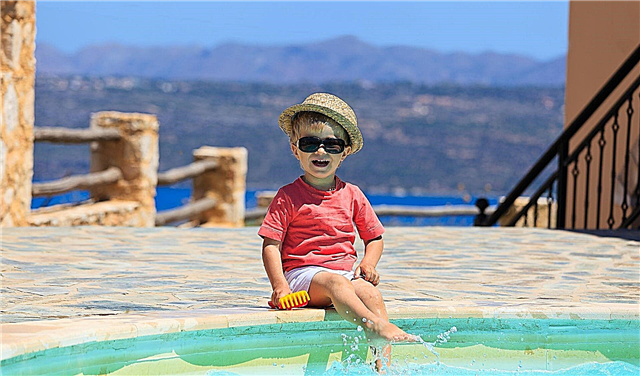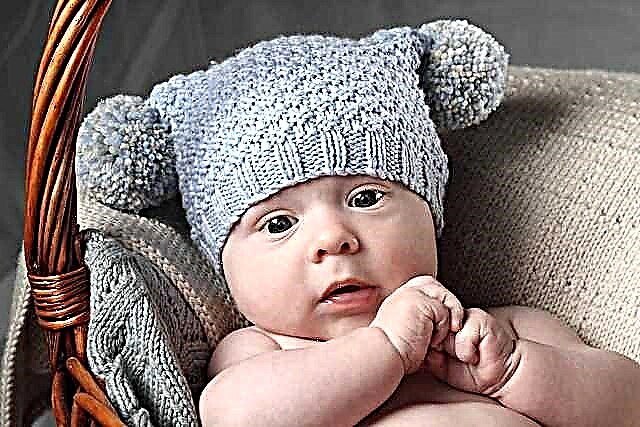
Almost every mother faces the appearance of various rashes on the face of a baby in the first year of life. Quite often, prickly heat leads to the occurrence of such changes on the skin. To eliminate all adverse manifestations, special hygienic care is required.
What it is?
The appearance of prickly heat on the skin should not cause panic in parents. This condition is often diagnosed in infants.
The localization of prickly heat can be different. Quite often it occurs on the face, on the head, on the neck. In some babies, skin rashes appear on the cheeks and forehead.
A pronounced violation of thermoregulation leads to the development of prickly heat in babies.
These situations often occur when babies are too wrapped or wearing clothes that cause the baby to overheat.


Caring parents quite often put on a lot of different things on the baby that contribute to an increase in body temperature and severe sweating. This contributes to the violation of thermoregulation and the appearance of characteristic symptoms of prickly heat.
Disrupted work of the sweat glands due to pronounced overheating leads to the fact that the baby has a strong sweating. Most often, this contributes to the appearance of prickly heat in babies in the first months of life. Such babies are in the crib for a long time, which causes them to develop adverse symptoms mainly on the face and upper body.


According to statistics, prickly sweat in babies often develops in the hot summer time. This is due to exposure to high ambient temperatures.
The prevalence of this pathology in the pediatric population is quite high. Every third baby has characteristic symptoms of this pathological condition.
The sweat glands of a newborn child have a slightly different structure than that of adults. In childhood, these anatomical elements are elongated and small in size.
With age, sweat glands acquire a branched structure. This feature leads to the fact that when exposed to any overheating or other provoking factor, the child develops strong sweating. Excessive sweat is irritating to the skin, which promotes severe inflammation.
The high-risk group includes premature babies, as well as babies with various anomalies in the structure of the skin and dermis. In such babies, thermoregulation is not yet working to the proper extent. This feature contributes to the development of various skin diseases, including prickly heat. Violations that occur when the sweat glands are disrupted, contribute to the appearance of rashes in the baby on the skin of the face.
Various microorganisms are always present on the skin, even in a newborn baby.


They are regular inhabitants of the skin and are required for local immunity. Heavy sweating leads to disruption of the normal biocenosis of the bacterial flora of the skin. This contributes to the fact that pathogenic microbes enter the skin, which can lead to the development of secondary infection.
What does it look like in newborns?
The first adverse symptoms may appear within a few hours after excessive wrapping of the baby. The severity of clinical signs may vary.
In premature babies, the symptoms are usually quite pronounced and manifest clearly. Each mother can identify them when examining her child.
Doctors identify several clinical variants of the disease. In the smallest patients, the red form of prickly heat is most common. This clinical variant of the disease is accompanied by the appearance of multiple rashes on the skin. A bright red rash most often occurs on the baby's face and cheeks.


The sizes of loose elements can be different, but usually reach 1-3 mm. Some babies have a tendency for the rash to merge. In this case, it takes on a different shape and bizarre shape. Red spots can also spread to the baby's neck and shoulders. This is especially pronounced in the smallest children, who still poorly hold their heads.
Also, a rash can appear in the area of skin folds. In babies of the first months, loose elements appear under the lower jaw or around the ears.
The most common type of this pathology, which mothers usually notice when examining their child, is prickly heat that occurs on the cheeks. Red spots on the skin can appear on other parts of the body.
Premature babies with persistent violations of thermoregulation have a tendency to spread skin rashes throughout the body.
When the secondary bacterial flora joins the process, multiple pustular formations appear on the skin. Inside these skin eruptions there is a purulent yellow or greenish content.
Quite often, pathogenic staphylococci or streptococcal flora become the cause of secondary infection. For the treatment of complicated forms of skin infections, various types of antibacterial drugs are already prescribed.


Quite often, with prickly heat, a child has only characteristic skin rashes. The general condition of the baby is practically not affected. The child remains quite active, playing with toys. Babies retain their appetite.
Only skin itching, which quite often accompanies the characteristic rash elements, can worsen the well-being of the child.
What might it look like?
The appearance of a rash on the skin of the face in babies can occur with a variety of diseases. In many cases, prickly heat resembles a child's allergy.
It is easy to confuse these pathologies when introducing new food products into the baby's diet, which are introduced as complementary foods. An allergic reaction causes not only the appearance of a rash in the baby, but also intolerable itching.
With allergies, the skin becomes quite dry. For prickly heat, increased sweating is characteristic, which makes the skin more moist to the touch. When you press the allergic skin rash with your finger, they disappear.


Collecting anamnesis in differential diagnosis plays a very important role. If, on the eve of the appearance of rashes on the cheeks, the child was introduced into the diet of some new food product, then this with a high degree of probability indicates that the baby has an allergic reaction. Several years ago, doctors used the term "diathesis" for this.
If the baby has a tendency to develop exudative rashes, then differential diagnostics should also be carried out with various types of exudative dermatitis, which occurs in many diseases of internal organs. A rash with prickly heat usually does not get wet and does not tend to form watery blisters.
The differential diagnosis of various diseases should be carried out by a pediatrician.
It is possible to independently identify the disease, however, only a doctor can establish the correct diagnosis.

In some cases, additional diagnostic tests are required. Usually babies undergo general clinical tests to determine the degree of functional disorders.

Complications
If a child develops prickly heat, but does not receive proper hygienic care, the course of this pathology can have a very unfavorable course:
- The most common complication is secondary infection. Staphylococcal and streptococcal flora lead to the development of purulent formations on the skin.
- In some cases, babies develop multiple bubbles filled with a yellowish or cloudy liquid inside.
- When the infection spreads deep into the skin layers, local purulent abscesses may occur. They are characterized by the formation of sufficiently large purulent formations.


At the same time, the baby's well-being is greatly disturbed, his body temperature rises rapidly to 38-39 degrees, symptoms of intoxication are increasing. Treatment of purulent abscesses is only surgical.
Usually, the adverse symptoms of prickly heat in babies disappear completely in 7-10 days.
If the disease persists on the skin of the face for more than two weeks, then the parents should re-show the baby to the doctor. Quite often, the development of complications or improper hygienic care of a newborn baby leads to a protracted course of the disease.
Treatment
It is possible to cure the adverse symptoms of prickly heat on the face of a baby only with the help of proper skin care during daily baby care.


It is very important for parents to remember not to over-wrap their babies. Clothing for a small child should be chosen according to the weather, taking into account his age. Products must be made from natural "breathable" materials.
Taking proper care of your newborn baby's skin is an important part of a successful treatment. This helps the child get rid of skin rashes that appear on the baby's face. Every mother should know about proper skin care.
A very important component for the health of children's skin is maintaining the required temperature in the room where the baby is.

Normal the air temperature in the children's room should be within 20-22 degrees. This mode allows you to ensure the physiological functions of the skin and does not lead to overheating of the baby.
The optimum humidity in the children's room should be in the range of 45-60%. This indicator of the microclimate allows you to maintain proper moisture in the skin. Too dry air in the children's room causes severe dryness of the skin and contributes to the disruption of the functioning of the sweat and sebaceous glands.
In order for a child not to freeze while at home, he only needs a little undershirt and a warm blouse. Excessive wrapping, especially in things that are too warm and woolen, contributes to severe overheating of the baby and the appearance of bright red rashes on his skin.


To maintain healthy skin in infants, it is very important to regularly ventilate the premises. During them, the baby should be taken out of the children's room.
Usually 10-15 minutes is enough to ventilate the room where the child is. During colder seasons, the duration should decrease. To ventilate the children's room, it is enough to open only the window.
To remove excess sweat on your baby's face, wash your face. For this, ordinary boiled warm water of a comfortable temperature is used. It is impossible to use too hot water for washing babies and newborns, as this will only contribute to overdrying the skin.


General hygiene baths are also very important. This reduces the likelihood of skin rashes spreading from the face to the entire trunk.
Doctors do not recommend limiting the bath during the presence of a rash with prickly heat. Bathing water temperature should be between 36-38 degrees. After the bath, the baby's skin should be blotted with a soft towel. Particular attention should be paid to areas of natural folds and folds.
Some doctors recommend that you dry your skin naturally after the bath. This method is best used in the warm season. In winter and autumn, this method can only lead to hypothermia of the child.


Do not rub your skin strongly with a towel after taking a hygienic bath. This can lead to the infliction of various microdamages, which often become the "entrance gate" for the penetration of a secondary infection.
Do not swaddle your baby immediately after taking a hygienic bath. This should be done only after the skin has dried.
You should also choose comfortable and warm clothes for walking outside.
Pay particular attention to wearing a scarf and hat. They should be made of high quality materials and should not cause excessive sweating in the child. If, after the walk, Mom noticed that the child's head is too wet from profuse sweat, then it is better to replace the hat and pick up another one for the next walk.


Medication is also prescribed for prickly heat. Medicines in this case are prescribed by the attending physician. All drugs are prescribed topically, since no systemic disorders in a child with prickly heat occur.
Various ointments are actively used to treat rashes in the smallest patients. These medicines nourish dry skin well and help to eliminate all skin rashes that the baby has.
To treat the symptoms of prickly heat on the face in newborn babies and infants, sparing agents with a pronounced anti-inflammatory effect are used. These drugs should have a minimum of side effects and not cause dangerous effects even after prolonged use on delicate skin in children during the first months of life.

Quite often, to eliminate adverse symptoms on the face, doctors prescribe babies cream "Bepanten". This medicine contains active panthenol, as well as antiseptic additives. These components have a pronounced anti-inflammatory effect. They also help to protect baby's delicate skin from possible invasion of secondary bacterial flora. Smear "Bepanten" should be on previously cleansed skin.
The frequency and duration of use of this drug are determined by the attending physician who treats and monitors the baby. Usually pediatricians are involved in the treatment of prickly heat.

"Sudokrem" - another drug that can be used in babies to eliminate various skin rashes. When using this drug, it should be remembered that it can cause a pronounced drying effect, since it contains zinc. Do not use this remedy on babies with too dry skin.
In children with a tendency to the formation of exudative elements, it is used zinc ointment. It has a pronounced anti-inflammatory and drying effect. Active metabolites help prevent the development of dangerous secondary infections that occur on the skin when the bacterial flora penetrates. Usually this remedy is prescribed once a day.


Quite often, doctors recommend general strengthening therapy for babies. For newborn babies and infants, it consists in the appointment of multivitamin complexes. Vitamins A, C and E contained in such products have a beneficial effect on the functioning of the skin and improve the well-being of the child.
Infants who are bottle-fed must necessarily receive a sufficient amount of all vital vitamins and minerals.
For how prickly heat manifests itself in infants, see the next video.



